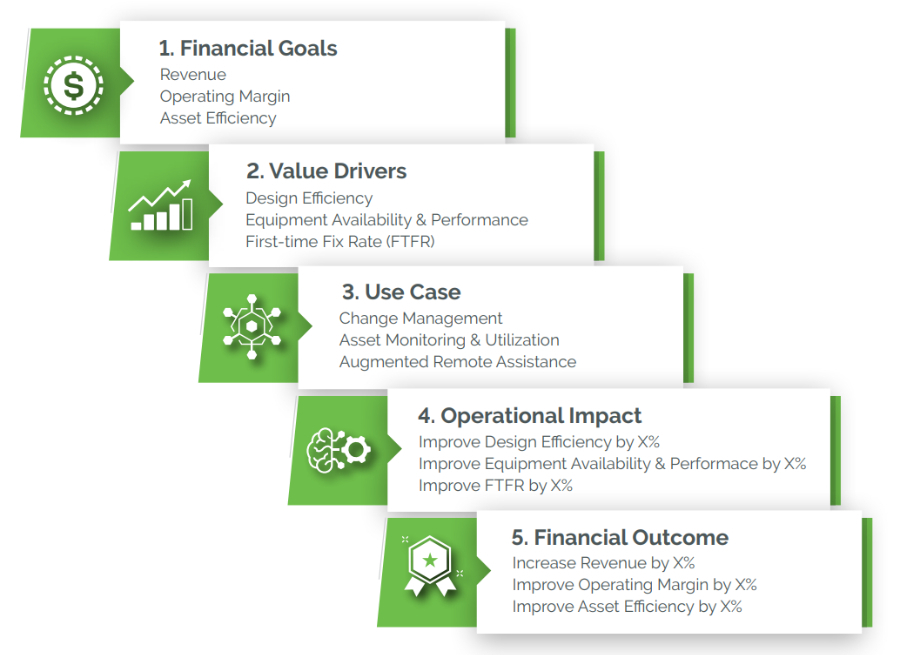5-Step Digital Transformation Framework
Digital transformation (DX) has risen to the top of strategic agendas for global companies. In fact, 92% of global manufacturers are on their DX journey. With these efforts, organizations are solving business challenges and creating new opportunities using technology – and it’s driving business value. According to McKinsey, digital transformation represents a multi-trillion dollar optimization opportunity to overcome challenges across their companies.
However, many companies are struggling to realize optimal value from digital transformation. A recent PTC survey found that across 1,500 DX projects, roughly half failed to show positive ROI. It begs the question—how can industrial companies ensure their DX efforts will deliver value? In a new paper from PTC, Identifying Value of Digital Transformation, a research-backed digital transformation framework is presented to help leaders frame and prioritize their initiatives on the business value it will bring to the organization.
What is a digital transformation framework?
A digital transformation framework is a way for business leaders to build a foundation for digital transformation success. Drawing on data, research, and experience, a DX framework finds common ground across various industries and use cases, to support leaders and organizations in their prioritization of DX initiatives.
PTC has leveraged deep domain knowledge from working closely on thousands of DX projects to create a value lifecycle process—a five-step guide to nail down the specific initiatives that will drive the most value based on your company’s unique needs. In our experience, one of the keys to success (and ROI) is aligning these projects to financial goals and prioritizing the ones that will impact financial and operational goals. While individual company internal assessments might be complex behind the scenes, these five considerations will help industrial organizations prioritize DX initiatives.
The Digital Transformation Framework to Realize Value Faster

Step 1: Align with Financial Goals
Revenue, operating margin, and asset efficiency: These are the big three financial goals for industrial enterprises. For DX to move the needle, the initiatives a company pursues must map back to one (or more) of those three primary areas.
Step 2: Identify Value Drivers
Identifying value drivers to address top challenges and unlock financial gains and goals is the next step. The value drivers vary across different functions: engineering, manufacturing, and service.
- For engineering, improving value chain collaboration increases revenue.
- For manufacturing, increasing equipment availability and performance benefits operating margins.
- For service, better first-time fix rates improves asset efficiency.
Read the full report for a breakdown of the value drivers across the enterprise.
Step 3: Select High-Value Use Cases
Now that you have an aligned financial goal and identified value driver, the next step is dig into specific use cases and select those that will result in the highest value for the company. This results in a short list of initiatives to pursue. Working with a trusted DX partner to choose the use cases, based on their experience and expertise, often yields a faster time-to-value.
Step 4: Measure Operational Impact
With the use cases set, companies need to ensure they identify the key performance metrics, create a baseline for current performance, and set expectations for anticipated performance. This all needs to be done before any changes are implemented. This sets the stage for proper measurement and the ability to adjust quickly. It’s critical in this step to analyze any shortcomings of expected value from DX projects and change processes accordingly as the company scales the initiative.
Step 5: Determine Financial Outcome
And now, once the program is implemented, we circle back to the beginning to ensure what we’ve done has made an impact on financial goals. The demonstration of impact at this level is fundamental to secure executive commitment and DX program success.
Final Thoughts
Digital transformation is a powerful concept with the capability to drive significant value to industrial enterprises. However, change is challenging. Organizations that use this digital transformation framework begin their effort with focus and clarity. They understand how their efforts will bring value in measurable and impactful ways. They’re clear on how DX can scale, which has the potential for compounding benefits across the value chain.
Ready to learn how this DX framework can be implemented in engineering, manufacturing, and service? For a deep dive into this framework and to put the value assessment into practical use, read the full whitepaper here.